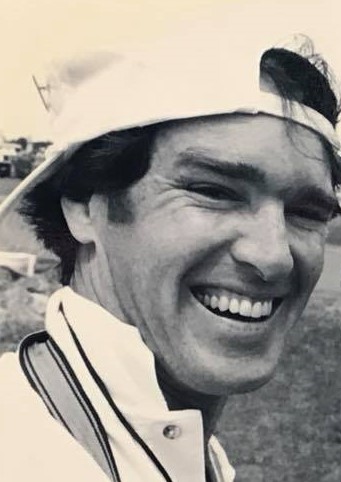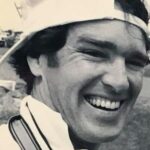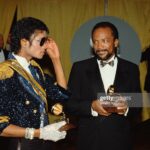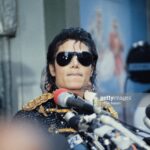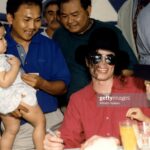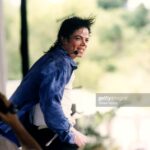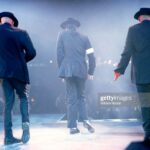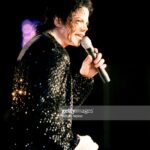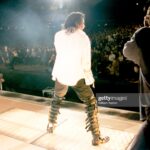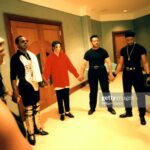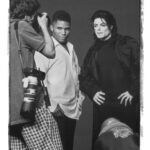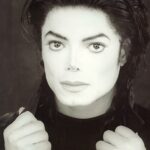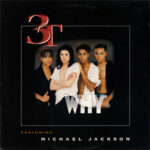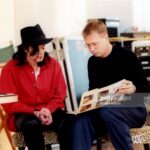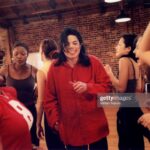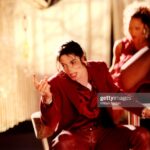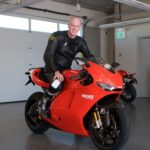In 1996, the promotion of the HIStory album was in full swing for our greatest pleasure. In addition to the videos, Michael Jackson was performing on television during ceremonies as if to announce his upcoming tour, not to mention the concert in Brunei. My desire to investigate this period is still present, and so I contacted photographer Bill Nation to evoke his memories on this subject. This is an opportunity to read the account of one of the players in the last successful promotion of a King of Pop album.
First, can you tell us how you grew a passion for photography and eventually made a career out of it?
Well, my father had cameras around and also movie cameras around. I grew up in Chattanooga, Tennessee and my father would always be shooting 16mm black and white films of my brothers and I growing up. He was fascinated about that. He had a family business making socks so first, he would make radio announcing and then when television was invented, he would go out and shoot his own sports reels with his camera, silent, and show it on the TV. He also had cameras around, in particular a Rolleiflex, a twin-lens camera, which I have now. He was always taking pictures and he taught my brothers and I. He set up a little dark room where the laundry area was and at night, he would black off all the windows and show us the magic of developing the film and having the pictures come up with the projector. I guess that’s where I liked the magic of it. Also, around our house, there were always Life magazines and National Geographic magazines so I was a reader – I looked at that a lot. I guess that’s where I got my fascination for it. I would shoot snapshots and I think during my last year at High School I did a little of work for the Yearbook, so that’s how I started exploring that. By the time I got to University in Tennessee, I got a job for the students newspaper which was what really woke me up because first, I had this great entree since I could go anywhere. If you got your camera, it was your passport – you would be invited in the places, you had access and a reason to be there. Technically, I was not very… good (laughs) but I got by and also got a little bit of money for what I liked doing. Of anything, I would say I was a photojournalist – I was very interested in the current events and news. So I finished University and got a job at the local newspaper with one of my friends. We tried to phase into the Gazette that had been there 30 years – we got assignments when people would come to town for concerts and such, and I got to photograph the concerts or politicians.
How did you work as a professional photographer before working with Michael Jackson?
Well, I was working full-time for the newspaper and from there, there was a series of guys that had gone to the Art Center College of design in Pasadena that I had known, and one guy, George Holt, who is actually today a really great fashion photographer, that we decided to follow and we ended up in Art Center College, a design school known around the world for their car work and design. Their photography department was really hot then and I stayed in California from then on – that was 1980 and I was like 25 years old, so that was fantastic! It was a 8-term program but I already had a degree so after 4 terms, I got hooked up and got a job where I traveled to Europe – they actually paid me a little bit of money and I photographed for a travel company. From there, I just started picking up jobs and typically the path is that you work as an assistant for photographers. One notable guy I got to work for was John G. Zimmerman – he was a very innovative sports illustrator photographer at the day and we got to photograph Christie Brinkley so that was cool! You’re kind of a photo slave but you’re learning a lot! At one point, I went to New York and things started to line up. I went to Sygma Photo News, the French news agency, and I said I wanted to work for them. The woman that was there at the time was the Los Angeles Operative Chief, Françoise Kirkland, and she was married to Douglas Kirkland who was also a pretty well-known fashion glamor photographer, and they started giving me jobs and assignments. The good thing with working for an agency was that I got to work every day whereas a lot of guys and girls I went to school with, as commercial photographers for instance, would get something but didn’t have anything to do for a certain period of time. As a photo journalist, I had to go out and make up things to do just to make sure I had images to send. One of the highlights of this period was when I did the OJ Simpson trial. I got hooked up with the Vanity Fair writer Dominick Dunne so I got really good insight stuff there and I actually still make residuals off of that. Then, you would do typical mods and floods and fires…
In this period, you took photographs of Michael Jackson at the Grammy Awards Ceremony and also on the day he inaugurated his star on Hollywood Boulevard, in 1984…
Well, because I was in L.A., I would occasionally see him in places but I absolutely had no contact – that was the press, you know, behind the ropes. At that time, I never had any dream that I would work for him full-time and I didn’t really have a vision of having a full-time job for one person, actually.
After already working for a good while, I got introduced to be Helmut Newton’s assistant when he and June were in Los Angeles. So for two winters I got to be his assistant and June’s sometimes. I went to Chateau Marmont and met him and we would get in the car, I would drive him around and we would do photo shoots. His technic was super simple, with only one light, me, a make-up person and that was that! Actually, he literally carried his gear around in a milk crate! (laughs) He was a very lovely man, very respectful to his people around, and Michael was too.
In 1996, you became one of his official photographers. How were you hired for this job?
My friend Jonathan Exley was MJ’s photographer. He has been my friend for a long time – we like car racing and I met him through motorcycling. He was a bit of a prima donna, and Michael Jackson wanted a photographer there all of the time because I think he was told earlier on by one of the Beatles that they wished they had shot more films and had more pictures to document everything they did. But my friend Jonathan wasn’t really interested in going in and hanging out for days when sometimes nothing happens and you never see him. Sometimes, I would just be there, either to hang with him with a camera or I would come in and have a full complete studio set-up with assistants and lighting, and he might come in.
Anyway, Jonathan thought it would be great for me to be the guy doing this. In February, Michael went to the UK for the BRIT Awards and he took John who took me as his assistant and mountain of equipment. This is when I got the first taste of this other way to operate. We got to stay in the Lanesborough Hotel in London – a really nice hotel, by the way!
How did your first meeting with Michael Jackson go?
So my first time I saw Michael Jackson was at a rehearsal for the BRIT Awards since he was going to do a number, and we were standing around maybe 50 people watching the stage. He came out wearing sweat pants or such, and kind of looking down, but when the music hit, he did his dancing and my jaw dropped! I was like « Wow! » You know, the way he moved back and forth and everything! After the number was over, Jonathan looked at me and said: « Yeah, when he turns it on, he turns it on! » And then Michael went back to some kind of low energy. That was my first view of him.
So we did our thing and Jonathan did some portraits of Michael and such and such, and he recommended me to Michael to start doing his day by day photography which implied staying around and being with him a lot. Eventually I think they figured out that for most of what they were doing, they would be using me. It was a little awkward because Jonathan wasn’t doing it but he was doing other works. That’s how I got picked up to do it but there never was a formal contract. I mean, I had to sign a mount of disclosures, and unfortunately I don’t have any of those images – all the work I did is probably sitting in some warehouse in San Fernando Valley.
So I started doing work with him and I went to Monaco once, for another award show and of course, I did video set work here in Los Angeles – for « Stranger In Moscow », « Blood On The Dance Floor », and I was Jonathan’s helper on « Scream », the video he did with his sister Janet. I remember it was just very, very white, and Jonathan would show me how the lighting setup worked. It was just a wall of light that took a lot of setup to do it. Things weren’t digital then so we used films and a lot of Polaroids – it was a different kind of world! I had never had a job when whatever I wanted to spend, well, that was what you spend – that was a difference! As a photo journalist with Sygma, I co-produced, which means I would spend my own money and then Sygma would reimburse half. We got a magazine assignment and that magazine would cover that, but it was a very different way of working and to get your head around out of work too. I would get pre-call and I would say I worked maybe 90 days a year – sometimes I would travel but mostly in town. I worked with a woman named Evy Tavashi – she was Michael Jackson’s office manager at his production office on Sunset Boulevard. There was always this little of uptight, nearly paranoid atmosphere and that was one thing I didn’t like about it because there were always concerns about images getting out that weren’t approved and things like that. One day, I was driving back from Northern California and I got a call from Evy on my cell-phone saying « Bill, there are some pictures in the Enquirer! » and I was like « What?! » Well, they weren’t mine ! (laughs) But it was always like walking on eggshells and I don’t know if it came from Michael or from the people around him. There were a lot of people that were kind of enabling because they were here to make a lot of money out of MJ, just being around him. He had this whole staff with him for a long time and they liked the way things were just going because it was a gravy train. My friend Jonathan who is a very insightful guy says he wished Michael would just decide to do like an unplugged or something because he was so super-talented. But everything became such a massive show and it was expensive to do anything, because I think Michael was very led, although he was a super-smart guy. There were a lot of people banked on the way that he was presented the way he was presented.
Would he mention any special instructions or demands regarding the photographs you would take?
I did some interacting. I mean, if I were where I was now, I would definitely interact more, but I would talk with him. It was mostly directing me in the photographs since he was very savvy – he would look at the polaroids and approve them saying « This looks good » or « Let’s bring the lighting here ». But I wasn’t back in his dress room or anything – he would come out when he was ready.
You were there while they were shooting the « Stranger In Moscow » video. Can you tell us about the behind the scenes of this project, please?
I liked that one because it was black on black with his black raincoat and a black background. But that’s kind of all I remember! (laughs)
And during this shooting, you also made the cover of the single « Why » with the 3T…
Yes!Michael was involved on this shooting. He brought them and he started working their costumes – he took their shirt and ripped them. He would say « No, not this way » and he directed me on that one.
Over the summer 1996, you took the pictures at Michael Jackson’s concert in Brunei. Can you share your memories about that show?
That was fantastic! We got word that he was going to go out on the road so they put a band together and dancers together because they had to put a whole act together. I think we worked in Santa Monica airport for a while. We had started gearing up and maybe I was a week ahead. They set up some stages out here to rehearse. That was fun! The dancers were fun people to hang around and also his costuming guy, Michael Lee Bush and Karen Faye – they were people I would really be with most of the time. To see this whole thing starting to be put together and there were maybe 50 people or so.
I believe the show was for the 50th birthday of the Sultan of Brunei and the plan was to be gone for 5 days. I had two assistants to go with me and they bought us all business class tickets on Singapore Airlines and we went to Singapore. Michael traveled separately from us on a charter plane he had. So we set up there, and the next day in Brunei we had a little time off so I went touring around with some of the musicians. There were some rehearsals in Brunei – the place was really humid! (laughs)
Taking pictures of an artist moving on a stage during a concert is obviously very different from taking pictures during a shooting. How did you envision your work on that particular show?
We always dressed in black so we would not be standing out, and what Michael wanted me to do was be on stage. I felt pretty comfortable with that sort of work because as a photo journalist, I’m used to be in the middle of things. So I would be on stage with Michael during the show, kind of back and forth sometimes, or I would go in front of him, between him and the crowd, and photograph him dancing – that was awesome! I was painting myself like « Well, I’m on stage with Michael Jackson in a show! » (laughs) That was fun! That was great!
So, we did the shows and he was well-loved there – he would go and meet people and walked in the crowd. He very liked people, I mean, he was in his environment that way. There were two guys, you know – the professional Michael and just Michael.
In addition to the pictures of his stage performance, did you also have to photograph Michael Jackson on his travels, following him as if you were his shadow?
What happened was I was in my hotel room, already getting to pack and go back, when they said « We need your passport. Michael is going to be moving around and you’re going with him. » I was like « Wow! » So he took myself, the videographer and his assistant, Michael Bush and Karen Faye – about 20 people altogether. We got on his charter plane with Michael and some friends. We flew to South Africa but he wouldn’t tell us where we were going! The guy who was running the show would just keep rolling his eyes, going « What is going on? Why are we still spending this money? » (laughs) We got in minivans and went to Soweto. Michael wanted to see a historical site about black revolution so we walked out of the vans. Nobody really knew we were there but we had to walk real fast. So we got up to where the monument was and all of a sudden we had to run because we were going to get mobbed! We ran back to the vans and the security guys were like « This is getting wild! » So we went back to the hotel.
The highlight of that, and one of the highlights of my life, actually, is that we were invited to be the surprise guests for Nelson Mandela at his birthday party. We pulled up outside of his house in a couple of vans, and they sent me and a local photographer to the front door to knock on the door. I knocked at the door, and Nelson Mandela opened the door, and here I was, this white guy from Tennessee who had heard all my life about him, shaking his hand! His hand was massive and I remember that because I thought of him breaking rocks when he was in jail for years and years… So all I could say was « Nelson Mandela. Michael Jackson. » (laughs) Michael came out of the van with his umbrella, and his fans were there too because they knew he was coming. There was a couple of other media invited too. We stayed for a couple of hours – there was actually a video-clip of inside the house. There is also a shot of me in there. That was awesome! Michael and he talked for a good while, and then they came back out of the house and did a little press briefing.
From there, we got on the plane and went to Marrakesh in Morocco. I think a promoter had invited him to talk about putting up a show there. We stayed a few days and were chased and mobbed everywhere. When you’re with Michael Jackson, you’re very popular! You’d better be ready to go and move fast! (laughs) Then again, the tour manager would be rolling his eyes because Michael wanted to go to Budapest! There was also a promoter there doing the F1 races and he wanted to talk to Michael about doing a show there. We spent a couple of days there which was a beautiful and fantastic place too. Finally, we flew back home but it was an amazingly fantastic week! I mean, how bad could it be?
After that, Michael did get some funding to put a tour together that I believe was supposed to start in Eastern Europe, so they used me a little bit. Then Michael found this guy he liked to use, John Isaac, because he wanted to work on a project of photographing children of the world. This guy had an history on doing books and things like that so I didn’t go on that trip.
Sony Pictures also had a project and I got contacted by them to go photograph Michael in this setup with the camera on tracks to shoot very fast so you could see all sides and make a 3D image of Michael. That was for the « Ghosts » video. So I took a couple of assistants to Amsterdam and we set up a studio over there – it was difficult because it was kind of new technology but I had some good help. When you work for Michael Jackson, I had manufactures offering me to loans of really fantastic camera gear and lighting.
It might have been in the middle of the tour or something – there was some stop, I believe, he didn’t go there just for that shooting. He was alredy there doing something in Amsterdam.
I remember I had been doing some go-cart racing before I got there and I had banged my knee. I didn’t know how to take care of it when I got over there, and my leg was all swollen but I kept working. There was some set doctor or something and he looked at me and said : « You have to go to the hospital! » So I went to the hospital and they took care of it. Michael was very generous so I got some tickets to one of the shows. He was always nice to us…
A picture from the shooting of the « Blood On The Dance Floor » video was used and turned into a painting for the album cover, but remained unreleased. Do you remember the original photograph and how it was chosen for the cover?
Yes, Michael did his own selects, and that was a fun shoot! The rehearsals were fun and he was living it up! It was a small dance crew with professional dancers and maybe a 2,000 square feet space we worked in. It was fun for me too, getting close with the lenses and working with him. The video is really pretty too – I thought it was one of the best things he did. Great energy! I love that suit he wore – that maroon leather suit. Vincent Paterson, who directed the shortfilm with Michael, was a really awesome guy! I did keep close to him, talking to him. I don’t know if they had worked together before but it seemed like he was bringing the energy out of Michael. I could see they collaborated a lot, and also he didn’t need all the special effects and crazy hairdressings and things like that – it was surely more what Michael does which is dance. It was much more pure on that project.
As far as the images, I did some studio setup but a lot of things was just from the video itself – I don’t think I did a lot of studio shoots. Once I had handed off my pictures, I didn’t have any input on how it was used for the painting.
Where do you hold these pictures among your career, both on the professional and emotional levels?
First, I appreciate you taking the time doing the interview, because I haven’t talked about that for a long time. I remember when Michael passed away, a local ABC affiliate did a little video interview with me.
Now, I am the owner and manager of a new motorcycle franchise. I’ve been doing it since 1998 but I miss the photography in that way that I was just so free. When I was a photographer, I would say « Well, I’m just going to take 3 weeks off and go rallyrace my car somewhere! » It was a very different lifestyle. I still like shooting pictures but I don’t know if I could try to make a living out of it. I do have a lot of images that I send to a guy every so often and he puts them in the Getty, but the residuals are so awful… I mean, I had a good bump last year because of something that OJ did, so I did a $3,000 sale out of OJ material. I shot people and people are newsmakers, so that’s always going to sell.
Obviously, Michael is the highlight of my commercial career, but it’s a shame that I didn’t have better access to be able to do something with these images. There was a disconnect with him passing away, but there is a lot of pretty awesome historical stuff there. It’s still sitting somewhere hopefully preserved. I would shoot lots of films and videos over time and I don’t know whatever anybody is going to do with that. I did get the impression that, when it came to the business, Michael had lots of people here to make a lot of money out of him, and they were very controlling and very careful about that. I was all set to go on that tour and I had gone out and bought $30,000 of gear, since we had agreed that they were going to run it for me, but then I was not on the tour anymore and they were gone! So it was big business and some people made it look like they were looking out for his best interest but they were looking out for their best interest.
When my last run was over working for Michael, I had pretty much lost most of my regular clients because with the unpredictability of working with him, I had to turn down stuff. I used to do a lot of magazine work for Forbes or the Daily or Vanity Fair but those had kind of all dried up. So I looked around and thought: « Hmm, after making what I was making, I don’t really want to go back to making $200 a day. » I had a business with a motorcycle Ducati leadership in Los Angeles which had started out as a hobbie business. So I kind of transitioned over to that in 1998-99 when photography started going digital which was interesting but you could see it was going to be a different world…
